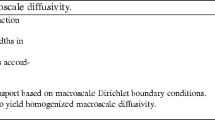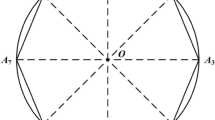Abstract
The present work establishes a reliable model to describe the influence due to the interfacial transition zone (ITZ) between cement paste and aggregates on the mechanical, thermal and diffusion properties of concrete. The mesostructure of concrete consists of aggregates with a random distribution embedded in the cement paste as well as the interface elements with zero-thickness representing the ITZ. In this work, the cohesive zone model (CZM) is used to model the debonding at the ITZ between cement paste and aggregates. Furthermore, a traction-separation law in CZM combined with micromechanically motivated thermal flux-separation relation and diffusion flux-separation relation is developed, thus enabling to describe the temperature jump and humidity jump across the cohesive crack.
















Similar content being viewed by others
References
Janssen M, Zuidema J, Wanhill RJH (2004) Fundamentals of fracture mechanics. Taylor & Francis, London
Kundu T (2008) Fundamentals of fracture mechanics. Taylor & Francis, Boca Raton
Shah SP, Ouyang CS (1992) Failure of concrete: fracture mechanics approach. Anal Mecán Fract 9:352–375
Murthy ARC, Palani GS, Iyer NR (2009) State-of-the-art review on fracture analysis of concrete structural components. Sadhana 31:345–367
Eckardt S (2009) Adaptive heterogeneous multiscale models for the nonlinear simulation of concrete. Ph.D. thesis, Bauhaus-Universität Weimar, Weimar, Germany
Elices M, Rocco C, Roselló C (2009) Cohesive crack modelling of a simple concrete: experimental and numerical results. Eng Fract Mech 76:1398–1410
Idiart AE, López CM, Carol I (2011) Chemo-mechanical analysis of concrete cracking and degradation due to external sulfate attack: a meso-scale model. Cem Concr Compos 33:411–423
Snozzi L, Gatuingt F, Molinari JF (2012) A meso-mechanical model for concrete under dynamic tensile and compressive loading. Int J Fract 178:179–194
Wong HS, Zobel M, Buenfeld NR, Zimmerman RW (2009) Influence of the interfacial transition zone and microcracking on the diffusivity, permeability and sorptivity of cement-based materials after drying. Mag Concr Res 761:571–589
Ramesh G, Sotelino ED, Chen WF (1996) Effect of transition zone on elastic moduli of concrete materials. Cem Concr Res 26:611–622
Nadeau JC (2003) A multiscale model for effective moduli of concrete incorporating itz watercement ratio gradients, aggregate size distributions and entrapped voids. Cem Concr Res 33:103–402
Lee KM, Park JH (2008) A numerical model for elastic modulus of concrete considering interfacial transition zone. Cem Concr Res 38:396–402
Carol I, López CM, Roa O (2001) Micromechanical analysis of quasi-brittle materials using fracture-based interface elements. Int J Numer Methods Eng 52:193–215
Häfner S, Eckardt S, Luther T, Könke C (2006) Mesoscale modeling of concrete: geometry and numerics. Comput Struct 84:450–461
Eckardt S, Könke C (2008) Adaptive damage simulation of concrete using heterogeneous multiscale models. J Algorithms Comput Technol 2:275–297
Snozzi L, Caballero A, Molinari JF (2011) Influence of the meso-structure in dynamic fracture simulation of concrete under tensile loading. Cem Concr Res 41:1130–1142
Willam K, Rhee I, Shing B (2004) Interface damage model for thermomechanical degradation of heterogeneous materials. Comput Methods Appl Mech Eng 193:3327–3350
Zavarise G, Wriggers P, Stein E, Schrefler BA (1992) A numerical model for thermomechanical contact based on microscopic interface laws. Int J Numer Methods Eng 35:767–785
Özdemir I, Brekelmans WAM, Geers MGD (2010) A thermo-mechanical cohesive zone model. J Comput Mech 46:735–745
Benabou L, Sun Z, Dahoo PR (2013) A thermo-mechanical cohesive zone model for solder joint lifetime prediction. Int J Fatigue 49:18–30
Sapora A, Paggi M (2014) A coupled cohesive zone model for transient analysis of thermoelastic interface debonding. J Comput Mech 53:845–857
Gérard B, Marchand J (2000) Influence of cracking on the diffusion properties of cement-based materials. Part I: influence of continuous cracks on the steady-state regime. Cem Concr Res 30:37–43
Kamali-Bernard S, Bernard F (2009) Effect of tensile cracking on diffusivity of mortar: 3D numerical modelling. Comput Mater Sci 47:178–185
Bentz DP, Garboczi EJ, Yang L, Martys N, Sakulich AR, Weiss WJ (2013) Modeling of the influence of transverse cracking on chloride penetration into concrete. Cem Concr Compos 38:65–74
Segura JM, Carol I (2004) On zero-thickness interface elements for diffusion problems. Intl J Numer Anal Methods Geomech 28:947–962
Segura JM, Carol I (2008) Coupled hm analysis using zero-thickness interface elements with double nodes. Part i: theoretical model. Intl J Numer Anal Methods Geomech 32:2083–2101
Segura JM, Carol I (2008) Coupled hm analysis using zero-thickness interface elements with double nodespart ii: verification and application. Intl J Numer Anal Methods Geomech 32:2103–2123
Mehta PK, Monteiro PJM (1993) Concrete: microstructure, properties, and materials. McGraw-Hill Professional, New York
Mehta PK, Monteiro PJM (2001) Concrete: microstructure, properties, and materials. McGraw-Hill Professional, New York
Wriggers P, Moftah SO (2006) Mesoscale models for concrete: homogenisation and damage behaviour. Finite Elem Anal Des 42:623–636
Comby-Peyrot I, Bernard F, Bouchard PO, Bay F, Garcia-Diaz E (2009) Development and validation of a 3D computational tool to describe concrete behaviour at mesoscale. Application to the alkali-silica reaction. Comput Mater Sci 46:1163–1177
Wang ZM, Kwan AKH, Chan HC (1999) Mesoscopic study of concrete I: generation of random aggregate structure and finite element mesh. Comput Struct 70:533–544
Moftah SO (2005) Computational homogenisation of concrete. Ph.D. thesis, Leibniz Universität Hannover, Hannover, Germany
Maso JC (1996) Interfacial transition zone in concrete. Rilem Report 11
Monteiro PJM, Maso JC, Ollivier JP (1985) The aggregate-mortar interface. Cem Concr Res 15:953–958
Day RA, Potts DM (1994) Zero thickness interface elements-numerical stability and application. Int J Numer Anal Methods Geomech 18:689–708
Zhang WH, Cai YQ (2010) Continuum damage mechanics and numerical applications. Springer, Berlin
Mazars J (1986) A description of micro- and macroscale damage of concrete structures. Eng Fract Mech 25:729–737
Mazars J, Pijaudier-Cabot G (1989) Continuum damage theory-application to concrete. J Eng Mech 115:345–365
Karihaloo BL, Fu D (1990) An isotropic damage model for plain concrete. Eng Fract Mech 35:205–209
Comi C, Perego U (2001) Fracture energy based bi-dissipative damage model for concrete. Int J Solids Struct 38:6427–6454
Halm D, Dragon A (1998) An anisotropic model of damage and frictional sliding for brittle materials. Eur J Mech A/Solids 17:439–460
Fichant S, Borderie CL, Pijaudier-Cabot G (1999) Isotropic and anisotropic descriptions of damage in concrete structures. Mech Cohes Frict Mater 4:339–359
Badel P, Godard V, Leblond JB (2007) Application of some anisotropic damage model to the prediction of the failure of some complex industrial concrete structure. Int J Solids Struct 44:5848–5874
Kim CM, Al-Rub RKA (2011) Meso-scale computational modeling of the plastic-damage response of cementitious composites. Cem Concr Res 41:339–358
Dugdale DS (1960) Yielding of steel sheets containing slits. J Mech Phys Solids 8:100–104
Chandra N, Li H, Shet C, Ghonem H (2002) Some issues in the application of cohesive zone models for metal-ceramic interfaces. Int J Solids Struct 39:2827–2855
Li S, Thouless MD, Waas AM, Schroeder JA, Zavattieri PD (2005) Use of a cohesive-zone model to analyze the fracture of a fiber-reinforced polymer-matrix composite. Compos Sci Technol 65:537–549
Park K, Paulino GH (2011) Cohesive zone models: a critical review of traction-separation relationships across fracture surfaces. Appl Mech Rev 64:1–20
Li SF, Zeng XW, Ren B, Qian J, Zhang JS, Jha AK (2012) An atomistic-based interphase zone model for crystalline solids. Comput Methods Appl Mech Eng 229–232:87–109
Tvergaard V (2003) Cohesive zone representations of failure between elastic or rigid solids and ductile solids. Eng Fract Mech 70:1859–1868
Ortiz M, Pandolfi A (1999) Finite deformation irreversible cohesive elements for three dimensional crack propagation analysis. Int J Numer Methods Eng 44:1267–1282
Alfano G, Sacco E (2006) Combining interface damage and friction in a cohesive-zone model. Int J Numer Methods Eng 68:542–582
Kolluri M, Hoefnagels JPM, van Dommelsen JAW, Geers MGD (2014) Irreversible mixed mode interface delamination using a combined damage-plasticity cohesive zone enabling unloading. Int J Fract 185:77–95
Biel A, Stigh U (2010) Damage and plasticity in adhesive layer: an experimental study. Int J Fract 165:93–103
Daher N, Maugin GA (1986) The method of virtual power in continuum mechanics application to media presenting singular surfaces and interfaces. Acta Mech 60:217–240
Lipton R (1997) Variational methods, bounds, and size effects for composites with highly conducting interface. J Mech Phys Solids 45:361–384
Yvonnet J, He QC, Toulemonde C (2008) Numerical modelling of the effective conductivities of composites with arbitrarily shaped inclusions and highly conducting interface. Compos Sci Technol 68:2818–2825
Le-Quang H, Bonnet G, He QC (2010) Size-dependent Eshelby tensor fields and effective conductivity of composites made of anisotropic phases with highly conducting imperfect interfaces. Phys Rev B 81:064203
Javili A, McBride A, Steinmann P (2013) Numerical modelling of thermomechanical solids with highly-conductive energetic interfaces. Int J Numer Methods Eng 93:551–574
Yvonnet J, He QC, Zhu QZ, Shao JF (2011) A general and efficient computational procedure for modelling the Kapitza thermal resistance based on XFEM. Compos Sci Technol 50:1220–1224
Javili A, McBride A, Steinmann P (2012) Numerical modelling of thermomechanical solids with mechanically energetic (generalised) Kapitza interfaces. Comput Mater Sci 65:542–551
Hashin Z (2001) Thin interphase/imperfect interface in conduction. J Appl Phys 89:2261–2267
Benveniste Y (2006) A general interface model for a three-dimensional curved thin anisotropic interphase between two anisotropic media. J Mech Phys Solids 54:708–734
Javili A, Kaessmair S, Steinmann P (2014) General imperfect interfaces. Comput Methods Appl Mech Eng 275:76–97
Javili A (2012) Thermomechanics of solids accounting for surfaces and interfaces. Ph.D. thesis, Universität Erlangen-Nürnberg, Erlangen, Germany
Jang SY, Kim BS, Oh BH (2011) Effect of crack width on chloride diffusion coefficients of concrete by steady-state migration tests. Cem Concr Res 41:9–19
Zohdi TI (2004) Modeling and simulation of a class of coupled thermo–chemo–mechanical processes in multiphase solids. Comput Methods Appl Mech Eng 193:679–699
Erbts P, Düster A (2012) Accelerated staggered coupling schemes for problems of thermoelasticity at finite strains. Comput Math Appl 64:2408–2430
Hain M (2007) Computational homogenization of micro-structural damage due to frost in hardened cement paste. Ph.D. thesis, Leibniz Universität Hannover, Hannover, Germany
Wu T, Temizer İ, Wriggers P (2012) Computational thermal homogenization of concrete. Cem Concr Compos 35:59–70
Zhang MZ, Guang Y, van Breugel K (2011) Microstructure-based modeling of water diffusivity in cement paste. Constr Build Mater 25:2046–2052
Vasconcelos KL, Bhasin A, Little DN, Lytton RL (2011) Experimental measurement of water diffusion through fine aggregate mixtures. J Mater Civ Eng 23:445–452
Jeon SE (2003) Analysis of concrete structures with hydration heat and differential shrinkage. Ph.D. thesis, Korea Advanced Institute of Science and Technology, Daejeon, Korea
Author information
Authors and Affiliations
Corresponding author
Rights and permissions
About this article
Cite this article
Wu, T., Wriggers, P. Multiscale diffusion–thermal–mechanical cohesive zone model for concrete. Comput Mech 55, 999–1016 (2015). https://doi.org/10.1007/s00466-015-1149-y
Received:
Accepted:
Published:
Issue Date:
DOI: https://doi.org/10.1007/s00466-015-1149-y




